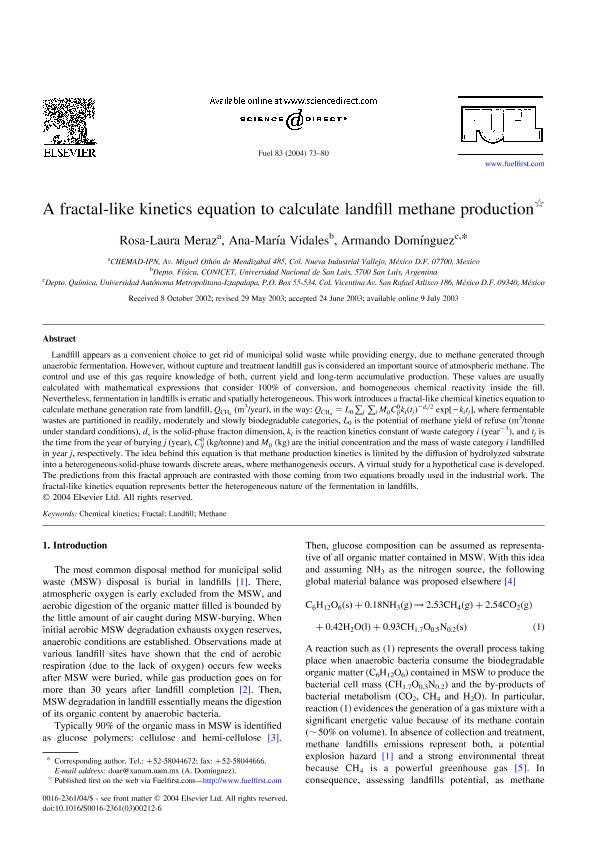Mostrar el registro sencillo del ítem
dc.contributor.author
Meraz Cabrera, Rosa Laura
dc.contributor.author
Vidales, Ana Maria

dc.contributor.author
Domínguez, Armando
dc.date.available
2021-07-30T12:02:15Z
dc.date.issued
2004-01
dc.identifier.citation
Meraz Cabrera, Rosa Laura; Vidales, Ana Maria; Domínguez, Armando; A fractal-like kinetics equation to calculate landfill methane production; Elsevier; Fuel; 83; 1; 1-2004; 73-80
dc.identifier.issn
0016-2361
dc.identifier.uri
http://hdl.handle.net/11336/137430
dc.description.abstract
Landfill appears as a convenient choice to get rid of municipal solid waste while providing energy, due to methane generated through anaerobic fermentation. However, without capture and treatment landfill gas is considered an important source of atmospheric methane. The control and use of this gas require knowledge of both, current yield and long-term accumulative production. These values are usually calculated with mathematical expressions that consider 100% of conversion, and homogeneous chemical reactivity inside the fill. Nevertheless, fermentation in landfills is erratic and spatially heterogeneous. This work introduces a fractal-like chemical kinetics equation to calculate methane generation rate from landfill, QCH4 (m 3/year), in the way: QCH4 = L 0∑j∑iMijCij 0ki(tj)-ds /2exp[-kitj], where fermentable wastes are partitioned in readily, moderately and slowly biodegradable categories, L 0 is the potential of methane yield of refuse (m3/tonne under standard conditions), ds is the solid-phase fracton dimension, ki is the reaction kinetics constant of waste category i (year -1), and tj is the time from the year of burying j (year), Cij0 (kg/tonne) and Mij (kg) are the initial concentration and the mass of waste category i landfilled in year j, respectively. The idea behind this equation is that methane production kinetics is limited by the diffusion of hydrolyzed substrate into a heterogeneous solid-phase towards discrete areas, where methanogenesis occurs. A virtual study for a hypothetical case is developed. The predictions from this fractal approach are contrasted with those coming from two equations broadly used in the industrial work. The fractal-like kinetics equation represents better the heterogeneous nature of the fermentation in landfills.
dc.format
application/pdf
dc.language.iso
eng
dc.publisher
Elsevier

dc.rights
info:eu-repo/semantics/openAccess
dc.rights.uri
https://creativecommons.org/licenses/by-nc-sa/2.5/ar/
dc.subject
CHEMICAL KINETICS
dc.subject
FRACTAL
dc.subject
LANDFILL
dc.subject
METHANEΓ
dc.subject.classification
Otras Ciencias Físicas

dc.subject.classification
Ciencias Físicas

dc.subject.classification
CIENCIAS NATURALES Y EXACTAS

dc.title
A fractal-like kinetics equation to calculate landfill methane production
dc.type
info:eu-repo/semantics/article
dc.type
info:ar-repo/semantics/artículo
dc.type
info:eu-repo/semantics/publishedVersion
dc.date.updated
2021-07-29T13:55:39Z
dc.journal.volume
83
dc.journal.number
1
dc.journal.pagination
73-80
dc.journal.pais
Países Bajos

dc.journal.ciudad
Amsterdam
dc.description.fil
Fil: Meraz Cabrera, Rosa Laura. Centro de Investigación y de Estudios Avanzados del Instituto Politécnico Nacional; México
dc.description.fil
Fil: Vidales, Ana Maria. Consejo Nacional de Investigaciones Científicas y Técnicas. Centro Científico Tecnológico Conicet - San Luis. Instituto de Física Aplicada "Dr. Jorge Andrés Zgrablich". Universidad Nacional de San Luis. Facultad de Ciencias Físico Matemáticas y Naturales. Instituto de Física Aplicada "Dr. Jorge Andrés Zgrablich"; Argentina
dc.description.fil
Fil: Domínguez, Armando. Universidad Autónoma Metropolitana; México
dc.journal.title
Fuel

dc.relation.alternativeid
info:eu-repo/semantics/altIdentifier/url/https://www.sciencedirect.com/science/article/abs/pii/S0016236103002126
dc.relation.alternativeid
info:eu-repo/semantics/altIdentifier/doi/https://doi.org/10.1016/S0016-2361(03)00212-6
Archivos asociados
